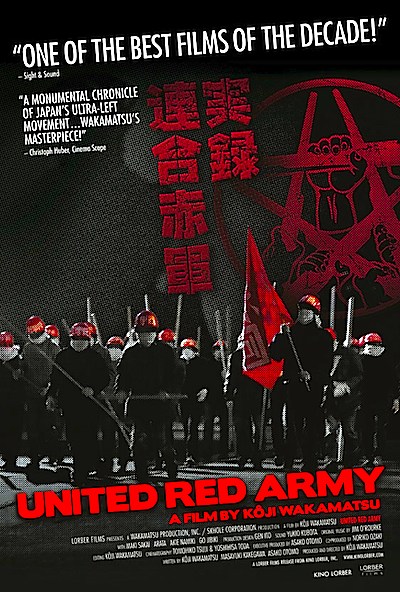By Joe Bendel. It was certainly red, but not always united. Former underground filmmaker Kôji Wakamatsu witnessed the Japanese New Left degenerate into a loose network of terrorist groups plagued by factionalism and internal power struggles. A sometime ally and contemporary of the militant paramilitaries, Wakamatsu has produced a chilling look at the inner workings of the militant left in United Red Army, which opens this Friday in New York at the IFC Film Center.
Wakamatsu leaves absolutely no doubt where the Marxist United Red Army (URA), as well as its Red Army Faction (RAF) and Revolutionary Left Wing (RLF) predecessors, were coming from. During one of many “self-critique” re-education sessions, their leader, Tsuneo Mori, pretty clearly spells out the need to sacrifice any sense of individuality and embrace death to advance the so-called class struggle. To do anything less is construed as counter-revolutionary, unless you happen to be one of the commanders.
 In his largely narrated opening sequences, Wakamatsu tries to suggest that the URA terrorists began as misguided anti-war protestors. However, they quickly evolve into violent hardcore Maoists (in fact, when Nixon makes his historic visit to China late in the film, it’s a real buzz-kill for the surviving URA faithful). In fact, as Wakamatsu tells the group’s history, one wonders if he realizes how much he actually reveals.
In his largely narrated opening sequences, Wakamatsu tries to suggest that the URA terrorists began as misguided anti-war protestors. However, they quickly evolve into violent hardcore Maoists (in fact, when Nixon makes his historic visit to China late in the film, it’s a real buzz-kill for the surviving URA faithful). In fact, as Wakamatsu tells the group’s history, one wonders if he realizes how much he actually reveals.
In the second, centerpiece segment of the film, the RAF consolidates with the RLF into the URA – taking to the mountains, ostensibly for military training. Yet, well before the revolution can possibly begin, the Red Army launches a reign of terror within its ranks. Here URA begins to resemble a horror movie, as one-by-one, loyal members are forced to undergo “self criticism,” clearly inspired by the Cultural Revolution, culminating with torture and fatal beatings.
URA concludes with the ill-fated Asama-Sansō hostage crisis, in which a remnant of the terrorist group held an innocent woman captive in her husband’s mountain lodge. Despite his personal disillusionment, Hiroshi Sakaguchi commands his men in this act of horrific folly. As disturbing as the final stand-off might ordinarily be, it is something of a let-down compared to the sheer gut-wrenching cruelty of the self-criticism sessions. What we see in URA is the sublimation of the individual to the collective—a textbook example of how cults work.
Much like Olivier Assayas’s Carlos (in which the United Red Army make a cameo appearance), Wakamatsu’s URA is a whirlwind of dates, places, riots, and terrorist attacks. Yet, as Mori and Hiroko Nagata, the leaders of the URA’s two constituent factions (who also happened to be surreptitiously sleeping together) Go Jibiki and Akie Namiki convey stone cold calculating menace, like nothing you have ever seen on film before. Conversely, Maki Sakai is absolutely haunting as Mieko Toyama, a former friend of Wakamatsu, who comes across as an idealistic peace activist led astray. Indeed, the director clearly wants to consider the entire URA and its militant cohorts in such terms, but he is undermined by the honest brutality of his film.
Wakamatsu is still very much associated with the Japanese far left and was banned from entering the United States when URA played at the 2008 New York Asian Film Festival. Whatever his intentions were with the film, it is a tough, disturbing look at violent leftism, unlikely to generate sympathy for his former comrades. Indeed, it shows the line between political extremism and outright insanity is porous at best. Shocking, grueling, and ultimately devastating, the three hour URA is a contemporary masterwork, forcefully recommended when it opens this Friday (5/27) at the IFC Center.
Posted on May 26th, 2011 at 1:14pm.
When I first started reading this piece, I immediately thought of “Carlos,” which mesmerized me for its entire five-hour run time.
There’s just something about examining these types of groups and individuals. I’ll definitely see this film the first opportunity I get.
Is it at all like “The Baader-Meinhof Complex”? It sounds similar: self-destructive nihilists (clothed in Marxist utopianism) willing to kill anyone to “save the world.” I’ll have to check it out.